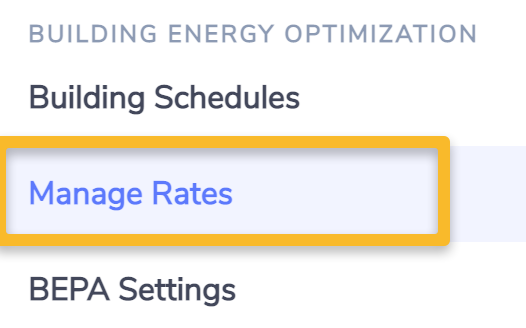Nominal Rates
Nominal rates are a type of target indicating cost per unit values and they are used in a few specific applications (mainly BEPA) within the platform.
Configuring Rates
The methodology and interface for configuring cost rates are similar to Bottom-up targets and Budgets. Just like those targets only one rate target type can be active for a given time period.
The Nominal cost rate can be accessed from the Admin menu:

Creating a new rate
To create a new rate from the Rates grid click on the +Create New button at the top right of the grid

This brings up the Create New Rate form:

Filling in the new Rate form...
Name – This is the name of the Rate target. While this name does not have to be unique it is considered best practice to give it a descriptive name. In the example above the name is 2018 Contracted Rate.
Description – This is an optional field where you can add a description of the Rate such as its purpose or how it was derived.
Target Type – There are two standard rates that can be configured – contracted rate (used in combination with a native unit target to derive a budget) and nominal rate (used in the BEPA module to estimate cost impacts of faults and issues).
Measured in – Always measured in Cost per unit.
Effective From – Sets the starting period of the rate. Target data cannot be captured in the target prior to this date.
Effective To – Sets the ending period of the rate. Target data cannot be captured in the target after this date.
Target Status – If the status is set to Active the rate will be used in the relevant function for that rate type. Note: there can be a 24hr delay after changing the status before the rate data is updated/removed in the datamart which provides data for the dashboards and reports.
Nominal Rate
The main use for nominal rates is in the BEPA module. Please review the BEPA module for more information about the nominal rate.
Contracted Rate
Contracted can be used in conjunction with a location-level Native Unit bottom-up target to generate a cost budget for use in dashboards and reports. This works by multiplying the native unit target value for a specific data type by the contracted rate value for that same data type.
Below is an example of a cost budget for electricity generated for a sample location using a contracted rate and native unit target:
Period | Native Unit target value (kWh) | Contracted Rate value (cost per unit) | Cost Budget value in dashboards and reports (local currency) |
|---|---|---|---|
Jan-2018 | 800 | 0.21 | 16,800 |
Feb-2018 | 900 | 0.21 | 18,900 |
Mar-2018 | 850 | 0.21 | 17,850 |
... | ... | ... | ... |
NOTE: If there is an active budget configured for the same time period it will be used preferentially over the combined rate + native unit target derived budget. |
